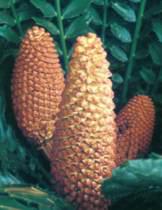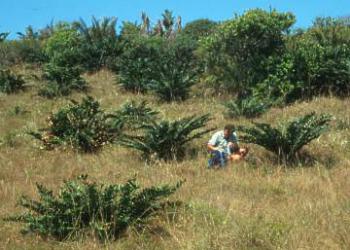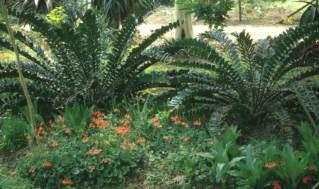Encephalartos ferox
Encephalartos ferox G.Bertol.
Family: Zamiaceae
Common names: Maputaland cycad, Zululand cycad, Tongaland cycad (Eng.), Maputalandbroodboom, Tongalandbroodboom (Afr.), umthobane, uthobani (Zulu), chihanga (Thonga)
SA Tree No: 3.4
Introduction
A cycad with dark green, arching, holly-like leaves and striking red cones.

Description
Description
The plants are usually single-stemmed or rarely branched with new suckers being produced from the base. The stems are subterranean (although very occasionally stems may be found reaching over a metre in length). The stems reach up to 35 cm across.
The arching leaves are 1-2 m long and bear numerous dark green, holly-like leaflets (15cm long and 3-5cm wide) with distinctly lobed teeth on both the upper and lower margin. The leaflets are moderately spaced at the base of the leaf, but are crowded and overlapping along the length of the leaf. Young leaves are often coppery brown and covered with fine hairs which are soon lost.

The most spectacular part of these plants are their striking orange-red to scarlet cones which contrast with the attractive dark green foliage. Occasionally golden yellow cones may be found. The male and female cones are borne on separate plants and while both colourful, are quite different from each other otherwise. The female plants bear 1-5 ovoid cones, each 25-50 cm tall and 20-40cm in diameter. The female cones are sessile on the plant (i.e. they have no stem). The male plants however bear 1-6 cylindrical cones per crown. These are longer (40-50cm) and much narrower (only 8-10cm in diameter). The male cones are held on short stems up to 3cm long.
The flesh-covered seeds are up to 5cm long and are a glossy bright orange to red in colour.
Conservation Status
Status
According to the Red List of South African Plants, checked on 10 October 2016, Encephalaratos ferox is asessed as Near Threatened (NT). Although widespread and common, this species is declining due to increasing collecting pressure and habitat destruction. Its population reduction is projected to be nearing 30% within three generations (generation length 30 years).

Distribution and habitat
Distribution description
Encephalartos ferox is a striking plant occurring in the coastal bush from northern KwaZulu Natal extending from Sodwana Bay to Kosi Bay and then further north along the Mozambique coastline to Vilanculos. It was first described in 1851 by Bertolini in Mozambique.
It is commonly found in the shade in dune forest margins and in wooded grassland where it may occur in large numbers. This species is locally abundant in dune scrub - sometimes occurring within 50m of the beach. Rainfall in this area varies from 1000 -1250mm per annum and no frost occurs. Fire is an important element in this plants habitat and may cause some damage to the stems and leaves. However this is usually superficial and the plant recovers quickly - resprouting from its largely underground stem.
Derivation of name and historical aspects
History
The name Encephalartos is derived from the Greek en meaning within; kephali meaning 'head' and artos meaning 'bread'. Ferox comes from Latin for 'fierce' or 'ferocious' in reference to the rigid, spiny leaflets.
Cycads are often referred to as "living fossils" because they appear to have changed little since the Carboniferous period 50-60 million years ago. Cycads are often confused with both palms and tree ferns because of a superficial resemblance - however they are actually totally unrelated. In fact, the word 'cycad is even derived from the Greek word cyckos meaning 'palm-like'.
Cycads belong to the group of plants called Gymnosperms (meaning 'naked seeds'). The reproductive organs are produced in cones (and not in flowers as in higher plants). The seeds are not enclosed in an ovary and no stigma or style is present. South African gymnosperms consist of the cycads (Encephalartos, Stangeria), the yellowwood trees (Podocarpus), the mountain cypress (Widdringtonia) and the well-known unusual desert plant Welwitschia.
Ecology
Ecology
The fleshy seeds are relished by many animals (baboons, vervet monkeys, dassies, fruit-eating bats) and birds (a particular favourite of the Trumpeter and Crowned Hornbills). They are attracted by the brightly coloured fleshy covering of the seed and are important agents of seed dispersal, spitting out the poisonous kernels once they have eaten the fleshy covering. The baboons and monkeys will often remove the entire cone (or parts of it) and carry it some distance away before eating the seeds.
Uses
Use
The Afrikaans name for cycads, broodboom, means 'bread tree' and the stems of these plants have been used in the past as a source of food. The starchy pith is removed, tied up in an animal skins, fermented and then ground into a meal.

Growing Encephalartos ferox
Grow
The Encephalartos ferox is popular in gardens and in the horticultural trade and is one of the more commonly available cycad species available in nurseries. It grows best in partial shade and require plenty of water. It is not tolerant of very severe frost.
This species may be propagated from seeds or by the removal of offsets or suckers.

In order for pollination to occur, it is essential to have both male and female plants in cone at the same time. Although pollination does occur naturally in the wild where populations are larger, pollination must be done artificially in a garden environment. The pollen needs to be collected from the male plants and may be stored in a freezer for many months. When the female cones are ready to receive pollen the cone scales open ever so slightly. Hand pollination can then be done by washing the pollen mixed with distilled water into the female cone.
Although seeds will always be produced by female cones, they will only be viable and germinate if they have been successfully pollinated. To determine if the seeds are fertile - remove the fleshy covering by soaking them in water for 2-3 days and then rubbing it off. Then put seeds in a bucket filled with water … the heavier fertile seeds will sink to the bottom and the infertile seeds will float on top.
The embryo develops in the seed immediately following fertilisation but it will take 6-7 months until it is ready to germinate. During this time, the cleaned seeds may be stored in a dry cupboard. Once the seed germinates, a tuberous tap root is immediately formed and once established, the first leaf will emerge. This is ±6 weeks after the emergence of the root.
Cycads are popular as collectors items and a number of species are highly threatened in their natural habitat due to overcollection. For this reason, all cycad species are protected by law and the trade in them is subject to approval by Nature Conservation. International trade in cycads is strictly controlled through the CITES legislation. This particular species of cycad, Encephalartos ferox, is still a relatively common species despite collection - however the KwaZulu Natal Nature Conservation Services consider it to be dependent on protection in nature reserves in the province.
References
- Donaldson, J. & Winter, J. 1998. Grow Cycads. Kirstenbosch Gardening Series. NBI : Cape Town.
- Giddy, C. 1974. Cycads of South Africa. Purnell : Johannesburg
- Goode, D. 1989. Cycads of Africa. Struik Winchester : Cape Town.
- Pooley, E. 1993. Trees of Natal, Zululand and Transkei. Natal Flora Publications Trust : Durban
- Jones, D.L. 1993. Cycads of the World. Reed Books : Australia
- Scott-Shaw, R. 1999. Rare and Threatened Plants of KwaZulu Natal and neighbouring regions.
- KwaZulu-Natal Nature Conservation Service : Pietermaritzburg
Credits
Sharon Turner
Walter Sisulu National Botanical Garden
February 2002
Plant Attributes:
Plant Type: Shrub
SA Distribution: KwaZulu-Natal
Soil type: Sandy, Loam
Flowering season:
PH: Acid, Neutral
Flower colour:
Aspect: Morning Sun (Semi Shade), Afternoon Sun (Semi Shade)
Gardening skill: Average
Special Features:
Horticultural zones








Rate this article
Article well written and informative
Rate this plant
Is this an interesting plant?
Login to add your Comment
Back to topNot registered yet? Click here to register.